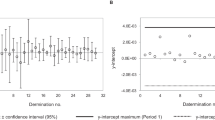Abstract
The assays of muscle arginyl (RAP) and alanyl (AAP) aminopeptidases and dipeptidyl peptidase IV (DPPIV) have been optimised using colorimetric (aminoacyl-p-nitroanilide) substrates in order to design an appropriate test in their assay in fresh pork meat. Kinetic parameters, Km and Vmax, were calculated for the three enzymes using pNa substrates. The rapid colorimetric analysis was developed and applied directly on the muscle extracts from 16 samples previously classified in different pork meat qualities. The exudative meat quality class (PSE) showed significant lower values for these enzyme activities than the ideal meat quality (RFN) and the dark, firm and dry (DFD) quality classes. The protocols can be easily transferred to food industry because the use of colorimetric substrates and a microplate colour reader are feasible to use in large-scale production systems.



Similar content being viewed by others
References
Armenteros M, Aristoy MC, Toldrá F (2009) Effect of sodium, potassium, calcium and magnesium chloride salts on porcine muscle proteases. Eur Food Res Technol 229:93–98
Blanchard P, Ellis M, Maltin C, Falkous G, Harris JB, Mantle D (1993) Effect of growth promoters on pig muscle structural protein and proteolytic enzyme levels in vivo and in vitro. Biochimie 75:839–847
Bradford MM (1976) A rapid and sensitive method for the quantitation of microgram quantities of protein utilizing the principle of protein-dye binding. Anal Biochem 72:248–254
Castro-Giráldez M, Fito PJ, Toldrá F, Fito P (2010a) Use of visible spectroscopy to assess colour development during ageing of fresh pork meat from different quality classes. Int J Food Sci Technol 45:1710–1716
Castro-Giráldez M, Aristoy MC, Toldrá F, Fito P (2010b) Microwave dielectric spectroscopy for the determination of pork meat quality. Food Res Int 43:2369–2377
Flores M, Aristoy M-C, Toldrá F (1993) HPLC purification and characterization of porcine muscle aminopeptidase B. Biochimie 75:861–867
Flores M, Aristoy M-C, Toldrá F (1996) HPLC purification and characterization of soluble alanyl aminopeptidase from porcine skeletal muscle. J Agric Food Chem 44:2578–2583
Flores M, Aristoy MC, Antequera T, Barat JM, Toldrá F (2009) Effect of prefreezing hams on endogenous enzyme activity during the processing of Iberian dry-cured hams. Meat Sci 82:241–246
Flores M, Aristoy MC, Antequera T, Barat JM, Toldrá F (2012) Effect of brine thawing/salting on endogenous enzyme activity and sensory quality of Iberian dry-cured ham. Food Microbiol 29:247–254
Garrido MD, Pedauyé J, Bañón S, Lopez MB, Laencina J (1995) On-line methods for pork quality detection. Food Control 2:111–113
Hernández P, Zomen L, Ariño B, Blasco A (2004) Antioxidant, lipolytic and proteolytic enzyme activities in pork meat from different genotypes. Meat Sci 66:525–529
Kauffman RG, Cassens RG, Scherer A, Meeker DL (1992) Variations in pork quality. National Pork Producers Council Publications, Des Moines
Kauffman RG, Sybesma W, Smulders FJM, Eikelenboom G, Engel B, Van Laack RLJM, Hoving-Bolink AH, Sterrenburg P, Nordheim EV, Walstra P, Van der Wal PG (1993) The effectiveness of examining early post-mortem musculature to predict ultimate pork quality. Meat Sci 34:283–300
Lopez-Bote CJ, Toldrá F, Daza A, Ferrer JM, Menoyo D, Silio L, Rodríguez MC (2008) Effect of exercise on skeletal muscle proteolytic enzyme activity and meat quality characteristics in Iberian pigs. Meat Sci 79:71–76
Ruiz-Ramírez J, Arnau J, Serra X, Gou P (2005) Relationship between water content, NaCl content, pH and texture parameters in dry-cured muscles. Meat Sci 70:579–587
Somers C, Tarrant PV, Sherington J (1985) Evaluation of some objective methods for measuring pork quality. Meat Sci 15:63–76
Toldrá F, Flores M (2000) The use of muscle enzymes as predictors of pork meat quality. Food Chem 69:387–395
Toldrá F, Sentandreu MA, Flores M (2009) Muscle enzymes: exopeptidases and lipases (Chap. 7). In: Nollet MLL, Toldrá F (eds) Handbook of muscle foods analysis. CRC Press, USA, pp 111–128
Van Laack RLJM, Kauffman RG, Sybesma W, Smulders FJM, Eikelenboom G, Pinheiro JC (1994) Is colour brightness (L-value) a reliable indicators of water-holding capacity in porcine muscle? Meat Sci 38:193–201
Warris PD (1982) The relationship between pH45 and drip in pig muscle. J Food Technol 17:573–578
Warris PD, Brown SN (1987) The relationships between initial pH, reflectance, and exudation in pig muscle. Meat Sci 20:65–74
Watanabe A, Daly CC, Devine CE (1996) The effects of the ultimate pH of meat on tenderness changes during ageing. Meat Sci 42:67–78
Wood JD, Brown SN, Nute GR, Whittington FM, Perry AM, Johnson SP, Enser M (1996) Effects of breed, feed level and conditioning time on the tenderness of pork. Meat Sci 44:105–112
Acknowledgments
Grant PROMETEO/2012/001 from Generalitat Valenciana (Spain) is acknowledged.
Conflict of Interest
Mónica Flores has no conflict of interest. Fidel Toldrá has no conflict of interest. This article does not contain any studies with human or animal subjects.
Author information
Authors and Affiliations
Corresponding author
Rights and permissions
About this article
Cite this article
Flores, M., Toldrá, F. Optimization of Muscle Enzyme Colorimetric Tests for Rapid Detection of Exudative Pork Meats. Food Anal. Methods 7, 1903–1907 (2014). https://doi.org/10.1007/s12161-014-9834-6
Received:
Accepted:
Published:
Issue Date:
DOI: https://doi.org/10.1007/s12161-014-9834-6




